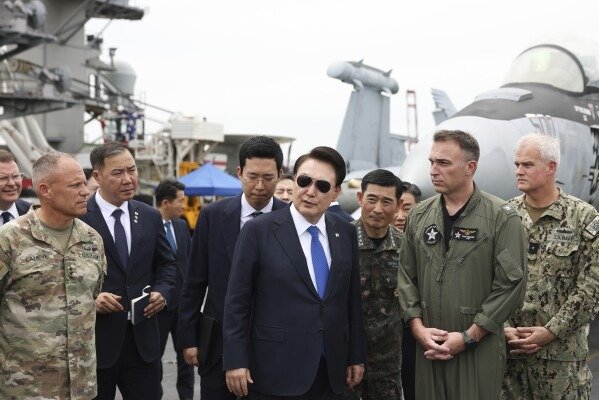South Korea, the United States, and Japan have launched large-scale joint military exercises known as “Freedom Edge,” featuring naval maneuvers and air-defense drills designed to enhance regional security and readiness. The drills, which involve advanced warships, fighter jets, and missile defense systems, signal the three nations’ commitment to deterring potential threats in the Asia-Pacific region.
The exercises come amid growing tensions with North Korea, which condemned the drills as reckless and provocative. Pyongyang accused the participating nations of escalating military pressure and vowed to respond with measures it deemed necessary to protect its sovereignty. State media in North Korea described Freedom Edge as a threat to peace and stability on the Korean Peninsula.
In Seoul, protests accompanied the start of the drills, reflecting domestic concerns about rising military tensions. Demonstrators called for restraint and emphasized the importance of dialogue over confrontation. Analysts say these protests highlight the delicate balance South Korea faces in maintaining its alliance with the U.S. and Japan while addressing public fears of escalating conflict.
Freedom Edge is part of a broader pattern of joint exercises in the region aimed at improving interoperability between allied forces. Officials from the three countries say the drills are defensive in nature and designed to strengthen coordination in response to potential missile threats, cyberattacks, and other security challenges.
The exercises include complex simulations of air-defense intercepts, maritime patrols, and joint operational command drills. These coordinated activities aim to ensure that forces can respond quickly and effectively to crises. Military analysts note that the scale and sophistication of Freedom Edge demonstrate the technological and strategic capabilities of the allied forces.
North Korea’s reaction underscores the persistent tensions on the Korean Peninsula. Pyongyang has recently increased missile testing, prompting regional and international concern. The Freedom Edge drills are seen as a clear signal to North Korea that the allies are prepared to counter aggression and safeguard stability in the region.
While the drills focus on security, they also carry diplomatic significance. By conducting exercises together, South Korea, the U.S., and Japan are reinforcing their trilateral alliance, demonstrating unity in the face of shared threats. Observers say this cooperation also sends a broader message to other regional actors about the strength of allied commitments.
The domestic protests in South Korea reflect a broader debate over military strategy and national security policy. Some citizens express concern that frequent large-scale exercises could heighten the risk of confrontation, while others argue that preparedness is essential in an unpredictable security environment. Government officials have emphasized that Freedom Edge is strictly defensive and carefully managed to avoid unintended escalation.
International observers are closely monitoring the drills, noting that their outcome could influence regional diplomacy. The exercises may affect North Korea’s next steps, potentially either deterring further provocations or prompting additional rhetoric and testing. Analysts stress that careful communication and ongoing diplomacy remain crucial alongside military readiness.
Freedom Edge is scheduled to continue over several days, with participating forces rotating through various scenarios to test coordination, response times, and tactical decision-making. The drills aim to ensure that all forces can operate effectively under joint command structures, which is critical for maintaining regional stability.
As the exercises unfold, the international community is watching both the military maneuvers and the reactions from Pyongyang and other regional powers. Freedom Edge military exercises highlight the complex interplay of deterrence, alliance-building, and diplomacy in a region facing persistent security challenges.







